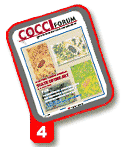Big Gains for Small Birds
Research, field trials show coccidiosis vaccination pays "even for lightweight birds
 Broussard: "Reactions are not as
severe as industry once believed.'
|
To be vaccinated for coccidiosis or
not to be vaccinated: For broilers
raised to lighter weights, that is
the question.
Why wouldn't producers want to
vaccinate birds 4.2 lbs and less?
One old school of thought suggests
that vaccinating birds marketed at light
weights against coccidiosis results in
performance loss. That's because vaccination
introduces live coccidial oocysts
to the chickens "a process that produces
a reaction and subsequent intestinal
disruption.
With vaccinated birds managed in a
40- to 42-day or even shorter production
cycle, decreased feed intake and
weight gain setbacks could be intensified,
and perhaps never overcome.
New Evidence
Fortunately, a new school is evolving
to empower small bird producers with
tools for vaccination program success.
"We're learning that vaccination
reactions are not as severe as industry
once believed," says Dr. Charles
Broussard, a technical service veterinarian
with Schering-Plough Animal
Health.
"There are now data to show that
growth rate following vaccination is not
as suppressed as originally anticipated,
especially when optimum management
procedures are in place and feed
digestibility is increased."
According to a recent study conducted
by Southern Poultry Research,
Inc. (SPR), Athens, Ga., the impact on
overall performance is temporary and
vaccinated birds do catch up or experience
what nutritionists call "compensatory
gain."
In the SPR study, the vaccine
Coccivac-B was administered at hatching
to a group of 960 chicks in a spray
cabinet. Starting at day 1, another nonvaccinated
group of 960 was fed salinomycin
in starter and grower feeds,
according to SPR president Dr. Greg
Mathis. Commencing on day 14, individual
weights and feed consumption
were evaluated weekly for all birds in
both groups.
At day 14, average feed conversion
and live weights were similar in the
vaccine and salinomycin groups,
Mathis reports. By day 21, the vaccinated
group trailed behind the nonvaccinated
group. However, after 21 days,
the vaccinated birds recovered and
began to gain. About day 28, performance
declined in birds receiving the
anticoccidial due to the presence of
subclinical coccidiosis. Under normal
management conditions, this is a typical
occurrence when this ionophore is
used, Mathis notes.
"We found that the differences
between treatments quickly diminish as
the vaccinated birds recovered and the
salinomycin birds were slightly affected,"
Mathis says. "By day 35, performance
in both groups was essentially the
same, and remained so throughout the
remainder of the study."
Diet Management for Small Birds
For vaccinated birds raised to 4 lbs at 38 days, poultry nutritionists generally recommend the following diet: |
No Room for Error
In order to optimize results with a vaccination
program for birds raised to
lighter weights, it is critical that producers
follow all the manufacturer's
recommended management procedures,
says Dr. Linnea Newman, a consulting
poultry veternarian based in
North River, N.Y.
"Move these birds into the full
house in 12 days or less, preferably 7
days," Newman advises. "Increased
stocking density can intensify the side
effects associated with a live coccidial
vaccine."
Specifically, these side effects
include oocyst and moisture accumulation
in the litter. Heavy oocyst accumulation
and high moisture can increase
vaccination reaction, which is undesirable
in birds destined for lighter processing
weights.
"Best results will be achieved during
warm weather, when good ventilation
and early movement to full house will
be part of the 'normal' management
program," Newman points out.
Be sure to maintain at least 4 inches
of a highly absorbent litter, such as
wood shavings or rice hulls, Newman
adds. Maintaining proper ventilation is
also critical.
"If you follow these guidelines, the
birds' reaction to vaccination will be
minimal, allowing flocks to achieve
weight and feed conversion comparable to ionophore programs even when
flocks are processed at 40 days or less,"
Newman says.
Brazil Experience
While approximately 70% of the 3 billion
broilers produced in Brazil each
year are raised for 42 to 49 days, or to
weights of 4.4 lbs to 7.04 lbs (2.2 kg to
3.2 kg), a significant number are
processed at lighter weights.
For starters, some Brazilian poultry
companies raise females for 34 days to
3.3 lbs (1.5 kg) for export to Middle
Eastern countries. Customers in that
part of the world purchase whole
chickens for individual consumption.
In some parts of Brazil, birds are
processed at 28 to 30 days of age when
they weigh 3.2 lbs to 3.4 lbs (1.45 kg to
1.55 kg).
There is also a special market in that
country for even smaller birds. About 5
million annually are processed under 3
lbs (1.36 kg). Routinely found on the
menus of Italian restaurants in Brazil,
they are known by a special name -
"galeto" in Portuguese "which means
"little chicken." The principal Brazilian
producer of these birds is a company
called Minuano, and the firm markets
galeto under the trademark "Minu."
About 50% of Brazilian birds raised
to 3.3 lbs (1.5 kg.) and smaller, or some
2.5 million birds per year, are vaccinated
for coccidiosis, according to Dr.
Vilson Simon, director of AviSui, the
poultry and swine division at Coopers
Brazil, a Schering-Plough Animal
Health subsidiary.
"I've never seen any outbreaks of
coccidiosis in these smaller vaccinated
birds," Simon reports.
Proper nutrition is the key to making
it work, Simon says. "We have
developed a special ration for vaccinated
birds that includes increased
amounts of protein, vitamins A and E,
and other micronutrients. This diet
helps keep weight gain on target during
the first 3 weeks of age when vaccine
reactions peak, reducing concerns
about compensatory gain at the end of
the feeding period," he explains.
"If you practice good flock management
but offer these small birds a poor
meal, it's likely you'll get poor results,"
Simon emphasizes.
Positive Results in U.S.
In September 2000, an independent
U.S. poultry company reported its
experiences with small bird vaccination
at a special CocciForum Symposium in
Colorado. According to the firm's presentation,
chickens raised to 4.2 lbs in
41 days exhibited no loss of performance
based on weight, feed conversion
and settlement cost for the first 2 weeks
on live vaccine compared to the 2 previous
weeks on the standard coccidiostat
program.
For a copy of the CocciForum/Durango
proceedings, which includes the U.S.
company's coccidiosis vaccine experience
and other related information, send your
name and address toS chering-Plough
Animal Health.
Fax: 908-629-3206
[email protected]







